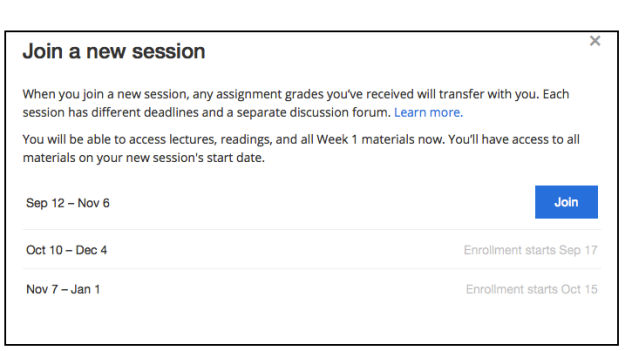1. MOOCs Scale Up with New Model
The search for a business model may soon be over for major MOOC players such as Coursera and Udacity. Udacity was the first to create partnerships between (mostly tech) companies to cover some of their course development costs. They’ve since moved to offering micro-credentials where students pay for Nanodegrees—focused skill training with a certificate-type credential upon successful completion. Students can also opt to pay even more for personalized services with Nanodegree Plus which includes career support and mock interviews. Coursera has something similar, minus the personalized services, with its ‘Specializations‘. But recently Coursera made another significant move—targeting the corporate sector. Smart. The learning and development market in the United States is vast; according to the 2015 Training Report there was a 14.2% increase in corporate training expenditures bringing the total budget for US companies to 17.6 billion. That’s big. Coursera is aiming to get part of the pie and fill the employee learning gap with “Coursera for Business”.
Today, we are taking yet another important step in our effort to expand the Coursera learner community. I am excited to announce Coursera for Business, our enterprise platform for workforce development at scale. We see Coursera for Business as a natural extension of our vision, and as a powerful way to help leading companies around the world address the rapidly evolving training and development needs of their employees. (Levine, 2016)
Insight: Given the size of the corporate employee learning and development market and the need for Coursera to generate revenue, it’s a logical move. More so given a recent study by McKinsey which suggested that companies are struggling to deliver relevant, just-in-time skill-training that fits in with the drive for productivity and need for employee-directed learning. Over 40% of companies surveyed indicated their current capabilities of meeting employee skill gaps are ineffective (Bensen-Armer et al). Coursera is on to something. MOOCs are not ‘free’ to produce or sustain; partnering with corporations is a win-win for everyone.
- Coursera for Business, Coursera Blog, Rick Levine
- Udacity’s Nanodegrees
2. MOOCs with Human Graders
When students sign up for the edX MOOC, “Introduction to Philosophy: God, Knowledge and Consciousness”, they’ll have the option to have their essays graded by a real person. This was unheard of when MOOCs first came on higher education’s radar in 2012. MOOC critics took issue with the automated and peer-review grading process—this undermined the learning process, comprised student learning according to the most vocal critics. This Fall MIT is experimenting with a new model for MOOCs with this particular course where essays are graded by a graduate assistant of MIT.
….the model is still a work in progress, and that details may change. This time around, MIT is paying one of its philosophy graduate student to serve as a course facilitator. The facilitator will effectively run the MOOC, moderating the discussion forum and grading papers. Hare declined to say how much the facilitator is paid, but added that it is a flat fee and more than what an adjunct instructor is paid to teach a residential course at MIT. (Straumsheim, 2016)
The cost for this MOOC that includes a Verified Certificate and personalized grading is $300, about $200 more than a Verified Certificate for other MOOCs in the same category (Philosophy & Ethics).
Insight: This story is yet another example how MOOCs are bringing awareness to online education, yet this recent development highlights how the MOOC label is misleading and needs to change. Lines are blurring between the many versions of online courses: 1. open and free courses, 2. online courses with a cost and no-credit (as the one in this article), 3. online courses for credit with a fee, and 4. online courses for a fee with conditional credit (students need to apply to institution to receive MOOC credit upon completion). Students need to be clear on the conditions when signing up for an online course, just as institutions need to be clear on what they are offering.
- Humans, the latest MOOC feature, Inside Higher Ed, Carl Straumsheim
3. Self-Paced MOOCs on the Rise
September is a big month for MOOCs and September 2016 is shaping up to be the biggest yet; at least since 2013 according to Class Central (Shah, 2016). But the big shift in MOOCs is the self-paced format which allows students to participate in MOOCs on-demand. Yet something is lost—the synergy of students working through the concepts at the same time (synchronous format) leading to discussion forums that fall flat.
Coursera has a workaround though, offering MOOCs within a cohort system, with courses that start back-to-back (see screenshot below) which allows students to transfer into the next class keeping their course-work intact.

Screenshot showing Courera’s new MOOC format that offers cohort-MOOCs more frequently meeting students’ needs for self-paced format
Closing Thoughts
The MOOC concept is transforming online education, yet the new formats are a far cry from the MOOC of 2012 which were Massive Open Online Courses.
References
- 2015 training industry report. (2015, November/December). Training Magazine, 20-33. Retrieved from https://trainingmag.com/trgmag-article/2o15-training-industry-report
- Bensen-Armer, R., Gast, A., & Van dam, N. (2016, May). Learning at the speed of business. Retrieved from http://www.mckinsey.com/business-functions/organization/our-insights/learning-at-the-speed-of-business
- Shah, D. (2016, September 5). MOOCs no longer massive, still attract millions. Retrieved from http://venturebeat.com/2016/09/05/moocs-no-longer-massive-still-attract-millions/
- Straumsheim, C. (2016, September 2). Massachusetts Institute of Technology experiments with instructor grading in massive open online course. Retrieved from https://www.insidehighered.com/news/2016/09/02/massachusetts-institute-technology-experiments-instructor-grading-massive-open







